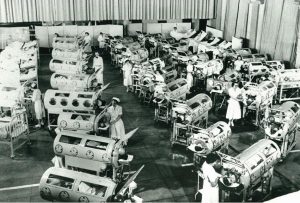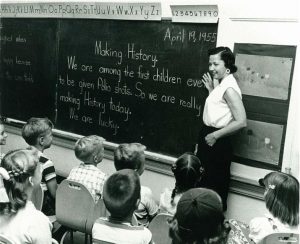Before polio vaccine: snapshots of life in the shadow of polio
Before the introduction of polio vaccine, little could be done to prevent children becoming infected by polio. The following pictures and footage give a snapshot of life in the shadow of polio, in Canada in the middle of the twentieth century.
The first video from Canadian Broadcasting Corporation (CBC) (without audio), shows compilation footage of polio victims and quarantining, using braces and helping the most severe cases to breathe with the help of large iron lung machines – at the time, these were the only measures available.
In this photo, a room full of polio victims live on lung support in Los Angeles 1952.

The second broadcast, also, from CBC is a radio report on a 1951 outbreak among the indigenous population in Northern Canada.
In this photo, a classroom full of children receive information on their polio vaccination in 1955 in the USA. With the development of polio vaccines and their mass application, North America is now polio-free.

Today polio still lurks in some of the world’s poorest and hardest to reach places, and strikes children in the most marginalized and neglected communities.
Polio cannot be controlled or contained within a specific area. Unless complete eradication is achieved, polio will quickly spread to unvaccinated children in polio-free areas. Eradicating polio means finding and vaccinating every last child, thereby eliminating all strains of the virus and stopping the disease dead in its tracks. And ensuring that the scenes in the footage above are never repeated.













